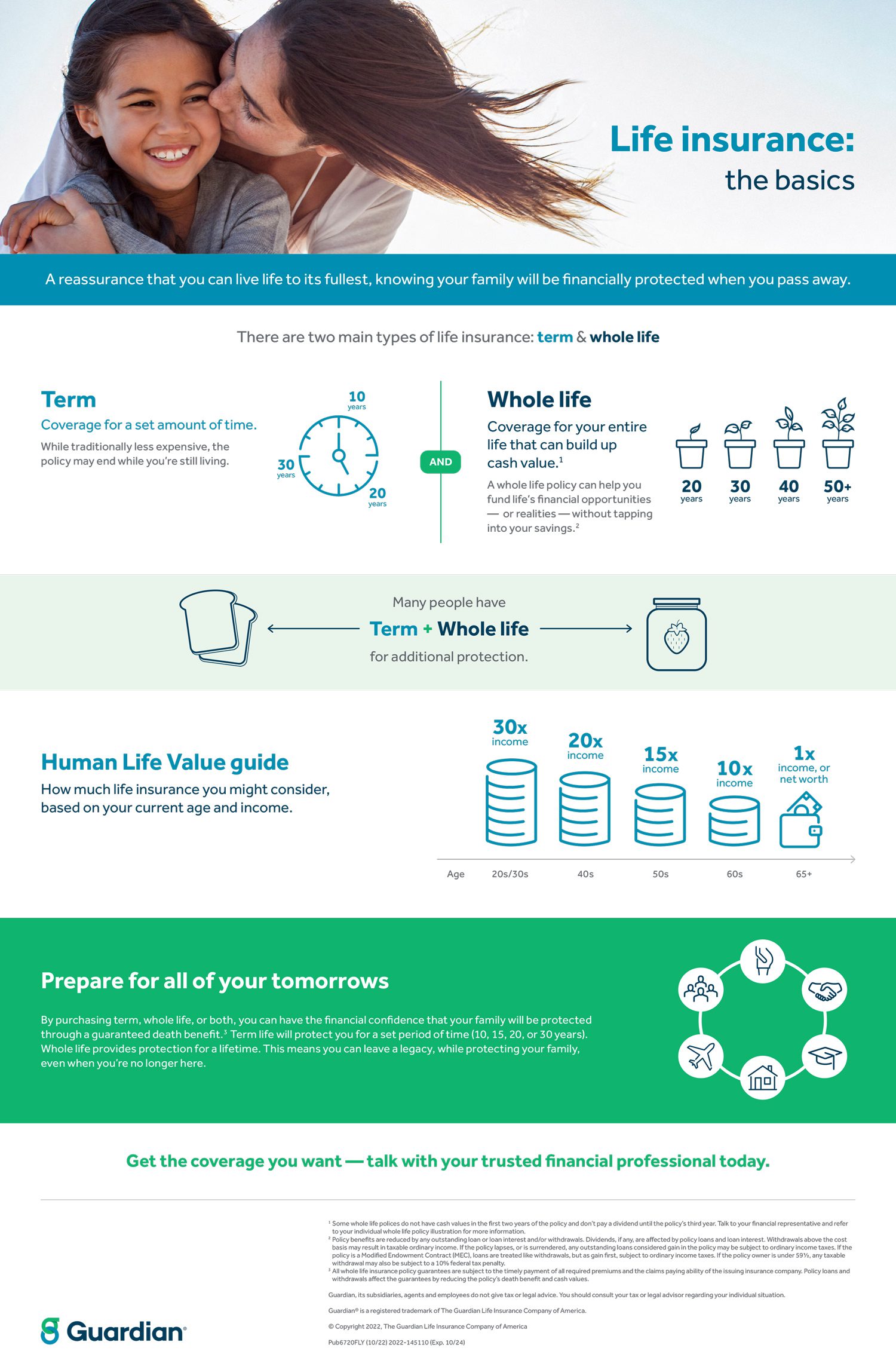Life insurance: The basics
This infographic illustrates the basic differences between term and permanent life insurance – and how much coverage a person might consider purchasing.

Infographic: Life Insurance: The Basics
This infographic illustrates the basic differences between term and permanent life insurance – and how much coverage a person might consider purchasing.
Life insurance: The basics
[Graphic of a woman embracing a little girl from behind and kissing her cheek.]
A reassurance that you can live life to its fullest, knowing your family will be financially protected when you pass away.
There are two main types of life insurance: term & whole life.
[Graphic of a clock with the usual location of the number 1 labeled as 10 years, the usual location of the number 4 labeled as 20 years, and usual location of the number 9 labeled as 30 years.]
Term: Coverage for a set amount of time. While traditionally less expensive, the policy may end while you’re still living.
Whole life: Coverage for your entire life that can build up cash value. 1
A whole life policy can help you fund life’s financial opportunities—or realities—without tapping into your savings. 2 [Graphic of four plants. From left to right, first plant has one leaf and is labeled 20 years; second plant has two leaves and is labeled 30 years; third plant has three leaves and is labeled 40 years; fourth plant has five leaves and is labeled 50+ years.]
Many people have term [arrow pointing toward graphic of two slices of bread] + whole life [arrow pointing to graphic of strawberry in jar] for additional protection.
Human Life Value Guide
How much life insurance you might consider, based on your current age and income.
[Pictorial graph presenting the following age groups labeled on the horizontal axis: 20s/30s, 40s, 50s, 60s, 65+. Above the label 20s/30s is a stack of six coins and the label 30x income. Above the label 40s is a stack of five coins and the words 20x income. Above the label for 50s is a stack of four coins and the words 15x income. Above the label for 60s is a stack of three coins and the label 10x income. A wallet with a bill sticking out is depicted above the 65+ label, along with the label 1x income or net worth.]
Prepare for all of your tomorrows
By purchasing term, whole life, or both, you can have the financial confidence that your family will be protected through a guaranteed death benefit.3 Term life will protect you for a set period of time (10, 15, 20, or 30 years). This means you can leave a legacy, while protecting your family, even when you’re no longer here.
[Graphic of five white circles arranged in a circular shape and connected with a white line. Each circle contains a picture. Clockwise starting at the top the pictures are as follows: a pregnant belly, two hands clasped in a handshake, a graduation cap, a house, an airplane, an image of four human figures from head to shoulders.]
Get the coverage you want—talk with your trusted financial professional today.
1 Some whole life polices do not have cash values in the first two years of the policy and don’t pay a dividend until the policy’s third year. Talk to your financial representative and refer to your individual whole life policy illustration for more information.
2 Policy benefits are reduced by any outstanding loan or loan interest and/or withdrawals. Dividends, if any, are affected by policy loans and loan interest. Withdrawals above the cost basis may result in taxable ordinary income. If the policy lapses, or is surrendered, any outstanding loans considered gain in the policy may be subject to ordinary income taxes. If the policy is a Modified Endowment Contract (MEC), loans are treated like withdrawals, but as gain first, subject to ordinary income taxes. If the policy owner is under 59 ½, any taxable withdrawal may also be subject to a 10% federal tax penalty.
3 All whole life insurance policy guarantees are subject to the timely payment of all required premiums and the claims paying ability of the issuing insurance company. Policy loans and withdrawals affect the guarantees by reducing the policy’s death benefit and cash values.
Guardian, its subsidiaries, agents and employees do not give tax or legal advice. You should consult your tax or legal advisor regarding your individual situation.
Guardian® is a registered trademark of the Guardian Life Insurance Company of America.
©Copyright 2022, The Guardian Life Insurance Company of America.
Pub6720FLY (10/22) 2022-145110 (Exp. 10/24)

